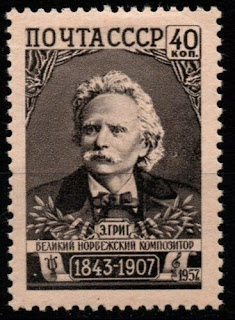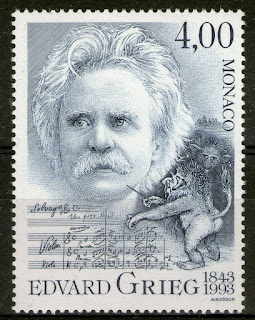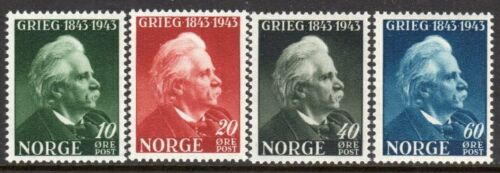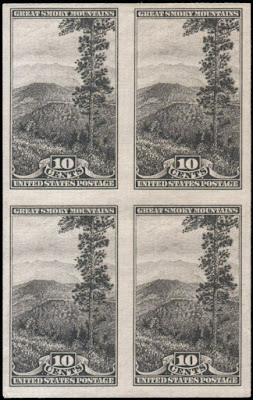Here are some events that happened on June 15th. It could be an event or a person that died or was born on that day
1843 Born: Edvard Grieg, Norwegian pianist and composer (d. 1907)
Edvard Hagerup Grieg (15 June 1843 – 4 September 1907) was a Norwegian composer and pianist. He is widely considered one of the leading Romantic era composers, and his music is part of the standard classical repertoire worldwide. His use and development of Norwegian folk music in his own compositions brought the music of Norway to international consciousness, as well as helping to develop a national identity, much as Jean Sibelius did in Finland and Bedřich Smetana did in Bohemia.
Grieg is the most celebrated person from the city of Bergen, with numerous statues depicting his image, and many cultural entities named after him: the city's largest concert building (Grieg Hall), its most advanced music school (Grieg Academy) and its professional choir (Edvard Grieg Kor). The Edvard Grieg Museum at Grieg's former home, Troldhaugen, is dedicated to his legacy.
Stamps from Russia, Monaco and Norway depicting Edvard Grieg
1888 – Crown Prince Wilhelm becomes Kaiser Wilhelm II; he will be the last Emperor of the German Empire. Due to the death of his predecessors Wilhelm I and Frederick III, 1888 is the Year of the Three Emperors.
Wilhelm II or William II (German: Friedrich Wilhelm Viktor Albert; 27 January 1859 – 4 June 1941) was the last German Emperor (Kaiser) and King of Prussia. He reigned from 15 June 1888 until his abdication on 9 November 1918 shortly before Germany's defeat in World War I.
The eldest grandchild of Queen Victoria, Wilhelm's first cousins included King George V of the United Kingdom and many princesses who, along with Wilhelm's sister Sophia, became European consorts. For most of his life before becoming emperor, he was second in line to succeed his grandfather Wilhelm I on the German and Prussian thrones after his father, Crown Prince Frederick. His grandfather and father both died in 1888, the Year of Three Emperors, making Wilhelm emperor and king. He dismissed the country's longtime chancellor, Otto von Bismarck, in 1890.
Upon consolidating power as emperor, Wilhelm launched Germany on a bellicose "New Course" to cement its status as a respected world power. However, he frequently undermined this aim by making tactless, alarming public statements without consulting his ministers. He also did much to alienate his country from the other Great Powers by initiating a massive build-up of the German Navy, challenging French control over Morocco, and backing the Austrian annexation of Bosnia in 1908. His turbulent reign ultimately culminated in his guarantee of military support to Austria-Hungary during the crisis of July 1914, resulting in the outbreak of World War I. A lax wartime leader, he left virtually all decision-making regarding military strategy and organisation of the war effort in the hands of the German General Staff. This broad delegation of authority gave rise to a de facto military dictatorship whose belligerent foreign policy led to the United States' entry into the war on April 6, 1917. After losing the support of the German military and his subjects in November 1918, Wilhelm abdicated and fled to exile in the Netherlands, where he died in 1941.
Stamp issued by Germany depicting Wilhelm II
Postcard depicting Wilhelm II
The eldest grandchild of Queen Victoria, Wilhelm's first cousins included King George V of the United Kingdom and many princesses who, along with Wilhelm's sister Sophia, became European consorts. For most of his life before becoming emperor, he was second in line to succeed his grandfather Wilhelm I on the German and Prussian thrones after his father, Crown Prince Frederick. His grandfather and father both died in 1888, the Year of Three Emperors, making Wilhelm emperor and king. He dismissed the country's longtime chancellor, Otto von Bismarck, in 1890.
Upon consolidating power as emperor, Wilhelm launched Germany on a bellicose "New Course" to cement its status as a respected world power. However, he frequently undermined this aim by making tactless, alarming public statements without consulting his ministers. He also did much to alienate his country from the other Great Powers by initiating a massive build-up of the German Navy, challenging French control over Morocco, and backing the Austrian annexation of Bosnia in 1908. His turbulent reign ultimately culminated in his guarantee of military support to Austria-Hungary during the crisis of July 1914, resulting in the outbreak of World War I. A lax wartime leader, he left virtually all decision-making regarding military strategy and organisation of the war effort in the hands of the German General Staff. This broad delegation of authority gave rise to a de facto military dictatorship whose belligerent foreign policy led to the United States' entry into the war on April 6, 1917. After losing the support of the German military and his subjects in November 1918, Wilhelm abdicated and fled to exile in the Netherlands, where he died in 1941.
Stamp issued by Germany depicting Wilhelm II
Postcard depicting Wilhelm II
1934 – The United States Great Smoky Mountains National Park is founded.
Great Smoky Mountains National Park is an American national park in the southeastern United States, with parts in Tennessee and North Carolina. The park straddles the ridgeline of the Great Smoky Mountains, part of the Blue Ridge Mountains, which are a division of the larger Appalachian Mountain chain. The park contains some of the highest mountains in eastern North America, including Clingmans Dome, Mount Guyot, and Mount Le Conte. The border between the two states runs northeast to southwest through the center of the park. The Appalachian Trail passes through the center of the park on its route from Maine to Georgia. With 12.5 million visitors in 2019, the Great Smoky Mountains National Park is the most visited national park in the United States.
The park encompasses 522,419 acres (816.28 sq mi; 211,415.47 ha; 2,114.15 km2), making it one of the largest protected areas in the eastern United States. The main park entrances are located along U.S. Highway 441 (Newfound Gap Road) in the town of Gatlinburg, Tennessee and Cherokee, North Carolina, and in Townsend, Tennessee. The park is internationally recognized for its mountains, waterfalls, biodiversity, and spruce-fir forests. In addition, the park also preserves multiple historical structures that were part of communities occupied by early settlers of the area.
The park was chartered by the United States Congress in 1934 and officially dedicated by President Franklin D. Roosevelt in 1940. The Great Smoky Mountains was the first national park whose land and other costs were paid for in part with federal funds; previous parks were funded wholly with state money or private funds. The park was designated as a UNESCO World Heritage Site in 1983 and a International Biosphere Reserve in 1988.
As the most visited national park in the United States, the Great Smoky Mountains National Park anchors a large tourism industry based in Sevier County, Tennessee adjacent to the park. Major attractions include Dollywood, the second most visited tourist attraction in Tennessee, Ober Gatlinburg, and Ripley's Aquarium of the Smokies. Tourism to the park contributes an estimated $2.5 billion annually into the local economy.
US stamps depicting the Great Smoky Mountains National Park









No comments:
Post a Comment